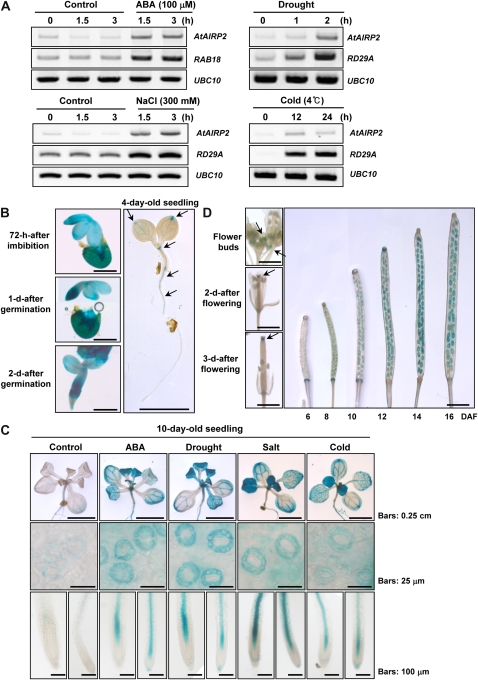Figure 2.
Expression profiles of AtAIRP2 in response to ABA and different abiotic stress conditions. A, Light-grown, 10-d-old Arabidopsis seedlings were treated with 100 μm ABA (1.5–3 h), drought (1–2 h), high salinity (300 mm NaCl for 1.5–3 h), or cold (4°C for 12–24 h). Total RNA was isolated from the treated tissues and used for RT-PCR. The RAB18 and RD29A genes were positive controls for ABA and abiotic stress responses, respectively. UBC10 was used as a loading control. B to D, AtAIRP2 promoter activity. AtAIRP2-promoter:GUS transgenic T3 plants were incubated with 5-bromo-4-chloro-3-indolyl-β-glucuronic acid for 12 h. AtAIRP2 promoter activity was visualized by GUS-specific staining. B, Histochemical localization of GUS activity in young seedlings (72 h after imbibition, 1 d after germination, 2 d after germination, and 4-d-old seedlings). Arrows indicate GUS signals. Bars = 0.25 cm. C, GUS-specific staining patterns in 10-d-old seedlings in response to ABA, drought, salt, and cold treatments. GUS signals were markedly induced in guard cells in rosette leaves and roots. Bar lengths are indicated to the right. D, GUS activity in mature plants. GUS signals were detected in anthers (flower buds), upper region of stigma (2–3 d after flowering [DAF]), and siliques (6–16 d after flowering). Bars = 0.25 cm. [See online article for color version of this figure.]

